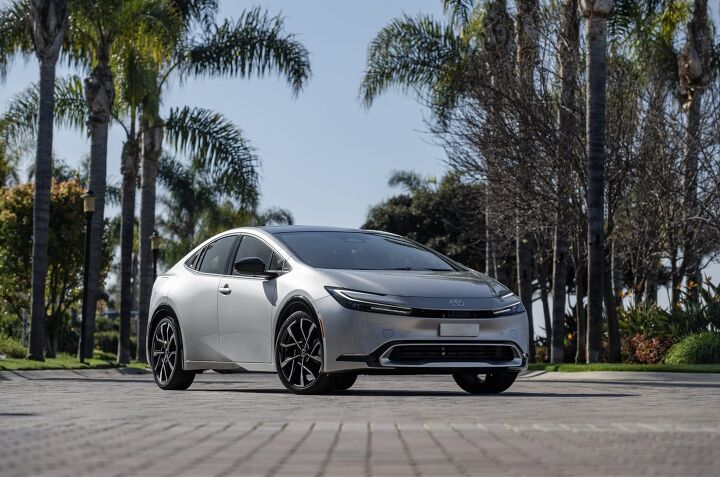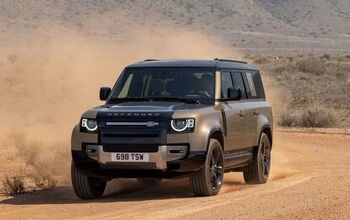2023 Toyota Prius Prime Review - Time For Me To Fly

2023 Toyota Prius Prime XSE Premium
No doubt you’ve seen it, whether here on TTAC, other websites or magazines (GASP! You actually read something other than TTAC!), or on the roads. One of the most daringly styled, attractive new cars on our roads wears a badge that has, for over two decades, been nothing but an ugly duckling camped out in the left lane at well less than the speed limit.
Well, our ugly duckling has grown into a swan. The 2023 Toyota Prius Prime is still a mileage champ, but it now has power and styling to befit its avian glow-up. The thing with swans is, well, they crap all over the place. Is this new Prius Prime a plugged-in pile of dung on a freshly-waxed showroom floor, or is it a genuinely graceful bird spreading its’ wings?
Yeah, Tim just reviewed the standard Prius last week. The timing is strictly coincidental - we are a good six weeks past the end of Toyotathon, if my calendar is correct, so we aren’t hawking any Oh, What A Feeling! feelings.
For those not down with the Toyota nomenclature, Prime stands for plug-in hybrid. That means you can hitch up to 120v or 240v in your garage and add power, rather than relying on the engine and momentum to charge the batteries as in a standard hybrid. Depending on the trim selected, you can get between 39 and 44 miles of all-electric range from a full charge in a Prius Prime, up to 84 mph. That’s a pretty decent daily commute without using a drop of fuel.
Engage both the electric motors and the 150 hp two-liter four and you’ll find 220 combined system horsepower. That’s a nice boost over the 194hp for the standard Prius, and nearly doubles the 121 combined system horsies found in the previous-generation Prius Prime. This hybrid is no longer slow. And it’s actually not bad to drive, either, as the handling remains predictable and comfortable. It’s no longer a penalty box - well, it’s not shaped like a box, more a penalty suppository - for those who are dead inside.
That steeply-raked nose and windscreen surely improve the already-wind-cheating profile of previous Priuses (Prii?) with a quoted 0.27 drag coefficient. There is still, like in every Prius, a fair bit of wind noise at highway speeds, but it isn’t objectionable.
I’m generally happy with interior comfort in this newest Prius Prime, though rear headroom is at a bit of a premium. My kids, both a couple inches under six feet tall, found their hair closer to the rear headliner than in most sedans. The seats were plenty supportive front and rear, and I feel as if I’d hear little to no complaining if we were to test the quoted 550 miles of estimated range per tank in a single stint. Standard lane-keeping assist and adaptive cruise control on all Prius Prime trims are part of the Toyota Safety Sense 3.0 suite of driver assistance technologies that help with that long cruise.
One caveat to those obsessives who read the data panel atop the page first before grooving into my magnificent prose: yeah, the price is up there. Forty-two grand and change for a compact family hatchback is hard to swallow. While the larger 12.3-inch touchscreen (versus eight inches on lesser trims) is lovely to look at, the glass roof nice to look out from, and the heated and ventilated front seats (as well as the optional-even-on-this top-trim $350 heated rear seats) are lovely, I honestly think the lesser SE trim would be a good buy for someone looking to save even more money and fuel. That SE trim weighs about 110 pounds less - some of which comes from the smaller 17-inch alloy wheels, as well as the steel roof above one’s head instead of glass - which leads to a significant fuel economy savings. Instead of 48mpg combined in the XSE and XSE Premium trims like you see here, an SE-package Prius Prime manages 52mpg combined, as well as 44 miles of EV range. All for a much more palatable figure of $34,070 delivered.
The automakers send us their best and most loaded vehicles to try out, of course, because that’s where they shine. And if you want the nicest, sexiest (I still wince when I type that) Toyota Prius Prime out there, this XSE Premium trim is the way to go. But these birds flock together, and there is value out there in the branches if you’re willing to look for the right winged eco-warrior.
[Images: Toyota]
Become a TTAC insider. Get the latest news, features, TTAC takes, and everything else that gets to the truth about cars first by subscribing to our newsletter.

Some enthusiasts say they were born with gasoline in their veins. Chris Tonn, on the other hand, had rust flakes in his eyes nearly since birth. Living in salty Ohio and being hopelessly addicted to vintage British and Japanese steel will do that to you. His work has appeared in eBay Motors, Hagerty, The Truth About Cars, Reader's Digest, AutoGuide, Family Handyman, and Jalopnik. He is a member of the Midwest Automotive Media Association, and he's currently looking for the safety glasses he just set down somewhere.
More by Chris Tonn
Latest Car Reviews
Read moreLatest Product Reviews
Read moreRecent Comments
- GregLocock Car companies can only really sell cars that people who are new car buyers will pay a profitable price for. As it turns out fewer and fewer new car buyers want sedans. Large sedans can be nice to drive, certainly, but the number of new car buyers (the only ones that matter in this discussion) are prepared to sacrifice steering and handling for more obvious things like passenger and cargo space, or even some attempt at off roading. We know US new car buyers don't really care about handling because they fell for FWD in large cars.
- Slavuta Why is everybody sweating? Like sedans? - go buy one. Better - 2. Let CRV/RAV rust on the dealer lot. I have 3 sedans on the driveway. My neighbor - 2. Neighbors on each of our other side - 8 SUVs.
- Theflyersfan With sedans, especially, I wonder how many of those sales are to rental fleets. With the exception of the Civic and Accord, there are still rows of sedans mixed in with the RAV4s at every airport rental lot. I doubt the breakdown in sales is publicly published, so who knows... GM isn't out of the sedan business - Cadillac exists and I can't believe I'm typing this but they are actually decent - and I think they are making a huge mistake, especially if there's an extended oil price hike (cough...Iran...cough) and people want smaller and hybrids. But if one is only tied to the quarterly shareholder reports and not trends and the big picture, bad decisions like this get made.
- Wjtinfwb Not proud of what Stellantis is rolling out?
- Wjtinfwb Absolutely. But not incredibly high-tech, AWD, mega performance sedans with amazing styling and outrageous price tags. GM needs a new Impala and LeSabre. 6 passenger, comfortable, conservative, dead nuts reliable and inexpensive enough for a family guy making 70k a year or less to be able to afford. Ford should bring back the Fusion, modernized, maybe a bit bigger and give us that Hybrid option again. An updated Taurus, harkening back to the Gen 1 and updated version that easily hold 6, offer a huge trunk, elevated handling and ride and modest power that offers great fuel economy. Like the GM have a version that a working mom can afford. The last decade car makers have focused on building cars that American's want, but eliminated what they need. When a Ford Escape of Chevy Blazer can be optioned up to 50k, you've lost the plot.










































Comments
Join the conversation
If you floor it in the new model (the only way to experience the extra horsepower) your not getting anywhere near the best fuel economy. So you can get the same mpg as a 20 year old car, or drive fast but not both at the same time.
The previous generation had a lower coefficient of drag, and got better fuel economy.